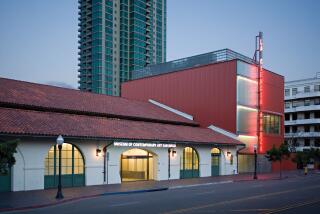U.S. Seeks to Save 1920s Rail Depot : History: Union Pacific reaches agreement with the Bureau of Land Management, which hopes to renovate Kelso site for a desert visitors’ center.
KELSO, Calif. — It looks like the folks in this hamlet (population 28) in the middle of the Mojave Desert are going to get their wish--the federal government will save the 67-year-old train depot that once served as the town’s center, its restaurant and, at times, its dance hall, courtroom and church.
If plans go as expected, the two-story, Mission-style stucco building will be saved by the U.S. government as a desert visitors’ center and museum. The Union Pacific Railroad had planned to tear it down.
The U.S. Bureau of Land Management announced Friday that the agency had reached tentative agreement with Union Pacific to acquire the Kelso Depot for $1, plus the cost of the surrounding land.
“We have already budgeted $195,000 to stabilize the depot and get it back in shape,” said Gerald E. Hillier, manager of the BLM district that includes the depot. “We are looking into the possibility of later leasing the old depot cafe and 20 hotel rooms on the second floor to the private sector.”
The BLM’s announcement is good news to desert groups, residents, ranchers, miners and others who banded together to launch the Kelso Depot Fund Drive. So far, the effort has raised $20,000 to be used in the restoration effort.
“It’s all we have out here other than a dozen homes and the cemetery,” said Arthur (O.B) O’Brien, 71, a prospector and a 20-year resident. “Saving and restoring the depot will mean a lot to this little town. Kelso, in northeastern San Bernardino County, is part of the East Mojave National Scenic Area, at the foot of an 8-mile-long, 13-mile-wide sand dune, 35 miles south of Baker, the nearest town.
It is still on the Union Pacific’s main line between Los Angeles and Omaha, but passenger service to the depot ended in the mid-1960s. After that, the depot was home to railroad workers maintaining the lines. But that ended five years ago.
For more than 50 years, though, the depot cafe, called the Beanery, was a popular spot for railroad workers and the public. From the 1920s through the 1940s, passengers would leave transcontinental trains to eat while the engines were serviced.
Everyone in Kelso now either works for the railroad or is related to someone who does, with two exceptions: O’Brien and Chester Haislip, 74, a retired soldier who moved here 20 years ago “because I like to be around trains.”
“This is a peaceful and quiet place. The eight boys and girls, children of railroad workers who live in town, are bused into Baker to school,” said Cheryl Brown, whose husband, Richard, maintains railroad switches and signals.
Crews based in Kelso cover 50 miles of tracks, switches and signals. They also water and trim a 30-mile stretch of salt cedar trees planted to keep windblown sand out of rail beds.
A few feet from the tracks near Kelso Depot are 38 freshly painted white crosses jammed together and surrounded by a white picket fence. There are no names on the crosses. Legend has it that bodies buried in the local cemetery were washed away in the early part of the century in a devastating flood.
The crosses commemorate the old graveyard but no one in town knows who was buried there.
More to Read
Sign up for Essential California
The most important California stories and recommendations in your inbox every morning.
You may occasionally receive promotional content from the Los Angeles Times.









